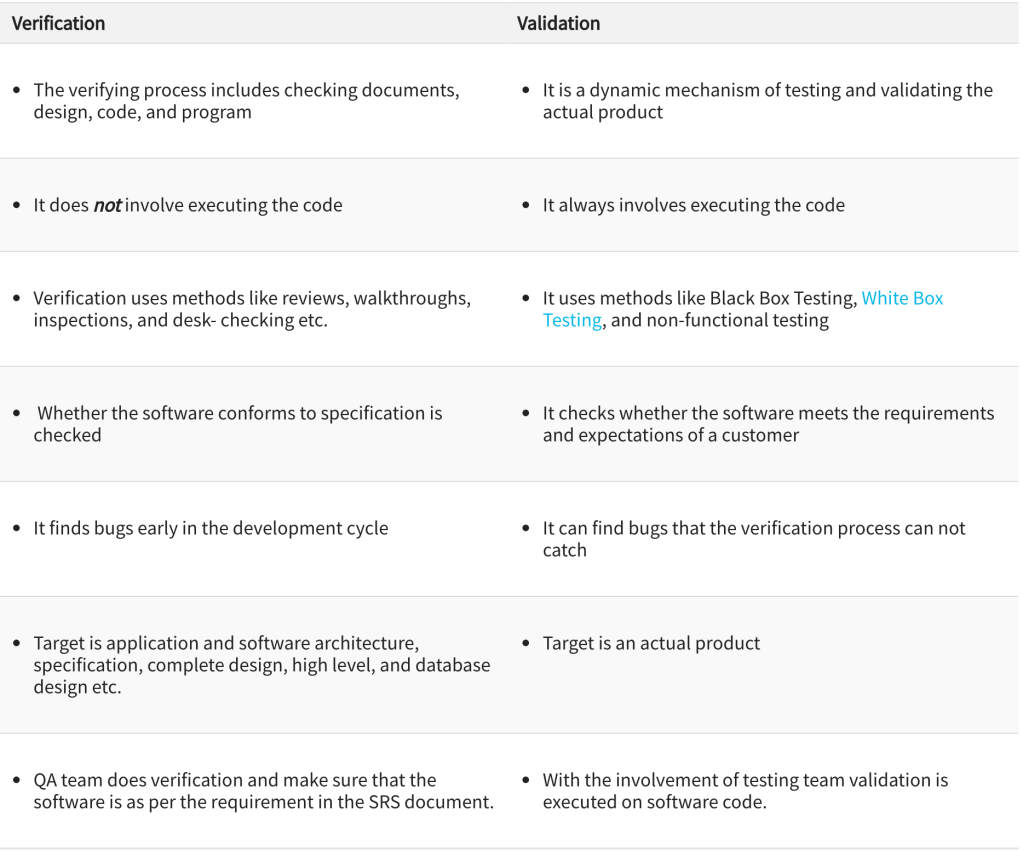Before anything, we have to know what is verification and validation of software. Verification is a process of checking documents, design, code, and program in order to check if the software has been built according to the requirements or not. The main goal of verification process is to ensure quality of software application, design, architecture etc. The verification process involves activities like reviews, walk-throughs and inspection.
Validation is a dynamic mechanism of testing and validating if the software product actually meets the exact needs of the customer or not. The process helps to ensure that the software fulfills the desired use in an appropriate environment. The validation process involves activities like unit testing, integration testing, system testing and user acceptance testing.

Here is an image of the key difference between them:

International Standards for V&V in software:
ISO 9001 Quality management systems – Requirements1 requires verification and validation to be planned and carried out and records kept (refer clauses: 7.3.5 Design and development verification and 7.3.6 Design and development validation)
IEEE 1012 – Standard for Software Verification and Validation2 provides a comprehensive how-to for software V&V planning and execution.
Software Review is a very important part of SDLC that assists software engineers in validating the quality, functionality, and other vital features and components of the software. As mentioned above, it is a complete process that involves testing the software product and ensuring that it meets the requirements stated by the client.
It is systematic examination of a document by one or more individuals, who work together to find & resolve errors and defects in the software during the early stages of Software Development Life Cycle (SDLC). Usually performed manually, software review is used to verify various documents like requirements, system designs, codes, «test plans», & «test cases».
But, why is software review important? well, the reason that it makes so important is the following:
- It improves the productivity of the development team.
- Makes the process of testing time & cost effective, as more time is spent on testing the software during the initial development of the product.
- Fewer defects are found in the final software, which helps reduce the cost of the whole process.
- The reviews provided at this stage are found to be cost effective, as they are identified at the earlier stage, as the cost of rectifying a defect in the later stages would be much more than doing it in the initial stages.
- In this process of reviewing software, often we train technical authors for defect detection process as well as for «defect prevention process».
- It is only at this stage the inadequacies are eliminated.
- Elimination of defects or errors can benefit the software to a great extent. Frequent check of samples of work and identification of small time errors can lead to low error rate.
- As a matter of fact, this process results in dramatic reduction of time taken in producing a technically sound document.
There are many different types of software review such as code review, technical review, walkthrough, inspections, pair-programming, software management review, software audit review.
If you want to know more about this visit this link:
https://professionalqa.com/types-of-reviews-in-software-testing